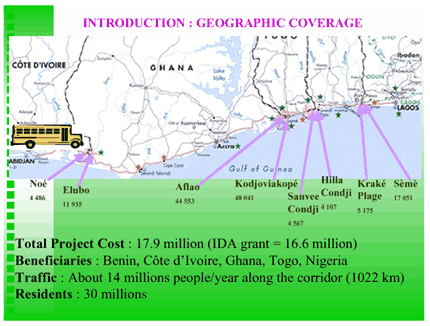|
Module 3: Promising Approaches for Mainstreaming Gender in Transport
3.9. Multi-Sectoral Approaches
It is increasingly clear that there are important opportunities for
mainstreaming gender in transport through multi-sectoral approaches.
These include specifically focusing on the linkages between transport
and:
- HIV/AIDS
- Maternal Health
- Credit, and Business Development
- Agriculture and Marketing
- Information and Communication Technologies
Combatting HIV/AIDS and in Transport Programs
The transport sector needs to play a key and proactive role in combatting
HIV/AIDS because it is a major vector of the disease. International
research shows that increased prevalence of HIV/AIDS is associated with:
1. The movement of people through the opening of new traffic routes
and improved access and mobility (from urban areas to rural areas; between
countries; between areas of high and low HIV prevalence).
2. The risky behavior associated with transport sector workers and
transportation hubs (for example, road construction workers and truck
drivers, truck stops, border posts, etc.).
Many transport ministries have begun addressing these issues by creating
HIV/AIDS units and programs which provide services to contractors and
local communities and creating HIV/AIDS policies for the sectors. In
addition, there are programs such as the Abidjan-Lagos Corridor HIV/AIDS
Initiative which is designed to specifically address HIV/AIDS awareness
and access to testing, counseling and condoms at border posts and sites
along this major corridor.
Case Example: Abidjan-Lagos Corridor HIV/AIDS Initiative
The HIV/AIDS Project for Abidjan-Lagos Transport Corridor aims to increase
access to HIV/AIDS prevention, basic treatment, support and care services
of vulnerable groups that reside along the Abidjan- Lagos transport
corridor. The project is active in five countries - Cote d’Ivoire,
Ghana, Togo, Benin and Nigeria. The project design phase included a
civil society and social assessment that revealed the limited capacity
of civil society organizations along the transport corridor . Most of
these organizations focused only on HIV/AIDS information dissemination,
education and communication, not on care and treatment. The project
has provided grants to Civil Society Organizations for community based
initiatives in HIV/AIDS care and support. In addition, the project has
adopted innovative ways to limit HIV transmission along transport corridors
by by making trans-national cooperation more effective through mass
media awareness raising campaigns, films, and involvement of local stakeholders
including religious leaders, traditional chiefs and commercial vehicle
drivers in the project activities.

- Holistic sub-regional approach to HIV/AIDS and free movement of
people & goods
- Awareness campaign with wide media coverage
- Three films produced and widely diffused
- Involvement of religious leaders and traditional chiefs
- Kiosks set up for condom sales
- Establishment of voluntary counseling and testing centers
Procedural Example: HIV/AIDS Prevention, Care and Treatment Requirements
for World Bank Road Construction Contractors
All World Bank Africa Transport Projects now include contract clauses
in the bidding documents which require contractors to provide all employees:
| Sample HIV/AIDS Monitoring Sheet
|
HIV/AIDS
M&E document: This monitoring sheet on HIV/AIDS
activities was created for the Ethiopia Roads Program. It
is submitted with the regular supervising consultant reports. |
|
- Prevention education
- Counseling and testing
- Referral for treatment
- Report on activities for monitoring and evaluation
Reducing Maternal Mortality

Photo: Courtesy of Riders for Health
Case Example: UHURU Vehicle Saves Mothers' Lives
There are several programs which are promoting bicycle and motorcycle
ambulances to help provide emergency access to healthcare facilities.
One organization which is especially active in making the link between
health and transport is Riders for Health (www.riders.com). The NGO
won the Development Marketplace award from the World Bank in 2004 for
the UHURU vehicles which are:
- Cost-effective, lightweight and extremely sturdy small capacity
motorcycles with sidecars which are fitted with off-road tires.
- Cost effective way to provide life-saving transport for pregnant
women with complications as well as serving as transport services
for educational and market access and, in some cases, providing power
generation for water irrigation and electricity.
Credit and Business Development Services for Female Transport Entrepreneurs

Photo Courtesy of Photoshare
- Providing access to financing enables women to pursue transport-related
businesses including farm related transport.
- Business development services help women manage and market their
services more effectively.
- Case Example : Maintaining boat engines provides economic opportunities
for Indian women who relied on credit to start their businesses.
Agriculture, Marketing and Transport
- Transport is a critical element for moving products to market and
accessing inputs such as fertilizer, seeds and equipment as well as
extension and market information.
- Most rural women have more limited access to land, labor, finance
and product markets which in turn limits their opportunities to increase
their productivity and income.
- It is important to take these constraints into account in agricultural
marketing projects and ensure that women have access to transport
and other resources needed to benefit from the program.
Case Example: Women's Group Uses Donkey Cart to Increase Farm Production
in Ghana
The Kolongo Women's Group in Ghana produces millet and other crops.
They purchased a donkey cart on credit from the local government through
a project to facilitate the movement of inputs and products to market
centers to increase production levels. The women's group also plans
to use the cart to ease domestic transport burdens for water and wood
transport.
Information and Communication Technology (ICT)
- ICT enables access to information, networking, experience exchange
and peer support.
- ICT is an important tool for entreprenership in all sectors including
transport.
- It is important to ensure that new ICT reaches out to rural communities,
women, girls, and youth.

Photo courtesy of Photoshare
Case Example: ICT
- Pondicherry
South India , a hub and spoke model allows village centers
managed by women to communicate via the Internet using wireless
and dial up telephone connections, solar power and main power.
The village centers transmit queries from local people to the
hub and share the responses.
|
|




